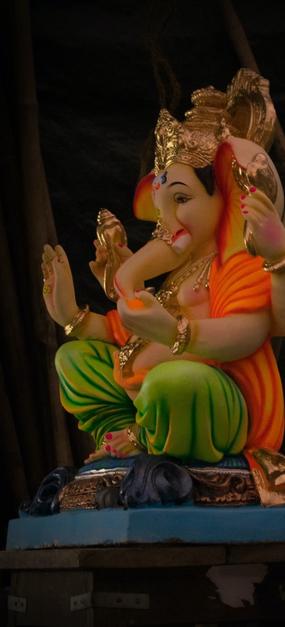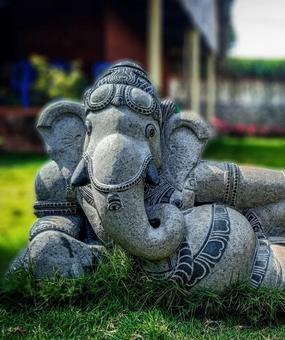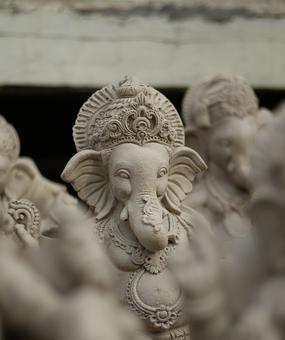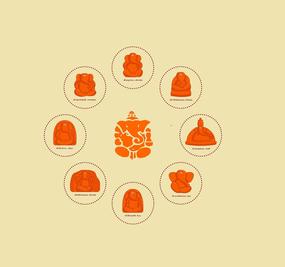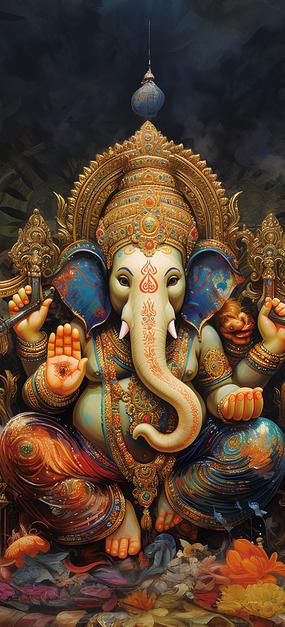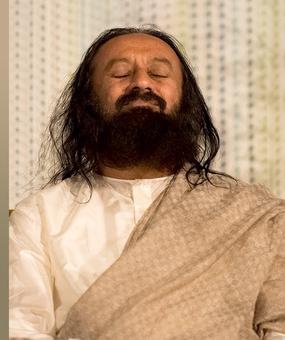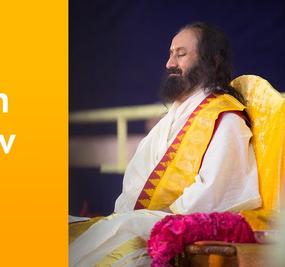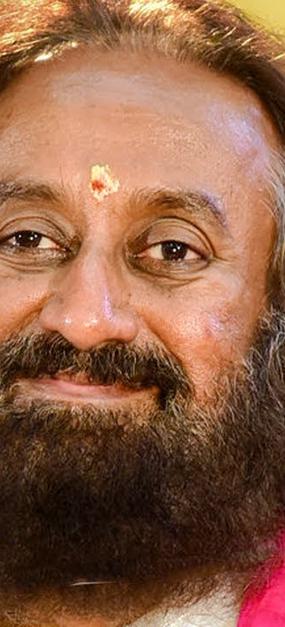Who is Lord Ganesha?
The ultimate truth in this existing world is that it is nothing but groups of atoms, groups of qualities, of energy. “Gana” means group and a group cannot exist without a Lord. Like the queen bee whose mere existence brings forth the honeycomb, this diverse universe in itself is enough evidence for Ganesha’s presence. Our own body is a ‘Gana’. It is made up of flesh, blood and bone marrow. The Lord of all ‘Ganas’ is ‘Ganesha’.
Ganesha is described as Ajam Nirvikalpam Niraakaaramekam. Shri Adi Shankaracharya Ji describes Ganapati in many beautiful ways. He sings, ‘Ajam nirvikalpam nirakaram ekam‘. This means that Ganesha is never born. He is Ajam (unborn), he is Niraakaar (formless), and he is Nirvikalpa (attributeless). So here, Adi Shankaracharya Ji says, ‘O Lord Ganesha! You are the eternal, formless divinity manifest everywhere.
Ganesha is ‘Achintya’, ‘Avyakta’ and ‘Ananta’. That is beyond thought, beyond expression and is eternal. Thus, no other is as beautiful as Him, and He is omnipresent.
Ganapati Atharvashesha glorifies Lord Ganesha in a beautiful hymn:
You are Lord Indra, Lord Brahma, Lord Vishnu, and Lord Shiva.
You exist in everyone’s form.
You are below me, behind me, above me, beside me, and all around me.
Everything is based on You.
You are the provider. You are the one who holds everything.
You are beyond all virtues.
You can be reached only through knowledge.
When sages meditate, the space element within them is You.
You are the chief of all groups.
You are the cause of this universe.
You are the seed. You are the manifestation of knowledge.
You are the chief of all gods. You are the beginning and end of all virtues.
You are the beginning of joy.
If someone experiences joy, it is only because of You.
You are the chief of all virtues.
There is no place in this world where You are not there.
Everyone, consciously or unconsciously, worships You. I
If any devotion arises from one’s mind, it is towards You.
Origin
Ganesha, or the lord, was born from the unmanifest transcendental consciousness, the Self, called Shiva. Just as when atoms get bonded, matter comes into existence; when all the fragmented aspects of the human consciousness get bonded, the divine happens effortlessly, and that is the birth of Ganesha from Shiva.
The stories in the Puranas contain many incredible and hard-to-believe occurrences. But they should not be interpreted as a nursery rhyme. Their language is complex and laden with great depth and meaning. We need to interpret these stories with a very refined state of mind.
Similarly, the story of Ganesha’s birth is full of hidden depth and meaning.. Ganesha was born out of the collection of dirt from Parvati’s body. Shiva and Parvati had been celebrating with great enthusiasm, and in the process, there was some dirt collected on Parvati’s body. This dirt signifies that celebration can easily become Rajasic or feverish and take you away from your centre.
The story continues that Parvati removed all the dirt (symbolic of ignorance) from her body and created a boy-doll from this. She gave the doll life and asked him to keep guard at the door while she bathed.
When Shiva (representative of supreme innocence, peace, and knowledge) returned to Kailasha, the boy could not recognize him and so obstructed his passage, preventing him from entering. This signifies that ignorance (dirt) does not recognize wisdom or innocence; however, the truth cannot be stopped by ignorance, and so Shiva chopped off the boy’s head – the head of ignorance and entered.
But when Parvati realized what had happened, she pleaded with Shiva that the boy was their son and Shiva had to save him. Shiva instructed his helpers to go and find someone with his head pointing to the North, someone in tune with the natural flow of energy, and to bring back his head. They searched far and wide and were only able to find an elephant in such a state. So they brought back the head of the elephant, and this became Ganesha. This is a story with great symbolism.
Why an elephant?
Now, the question arises as to why this one consciousness and one supreme power is depicted in the form of an elephant. The elephant is endowed with unique qualities, like its fearless and royal walk. It proudly destroys any obstacle on its path.
An elephant is also a symbol of authority, endurance, strength, and courage. So, to symbolize these qualities of the Divine, Lord Ganesha is depicted in the form of an elephant. And when we worship Lord Ganesha, we are able to imbibe all these qualities into our consciousness.
The long trunk of the elephant symbolizes that true enlightenment is a good balance between knowledge and its implementation in action. Ganesha has only one tooth that stands for ‘one consciousness’.
Science has discovered that within a single human DNA strand, there can also be found the DNA of every other species on the planet. Therefore, we also carry the quality of every animal in us; in fact, this has been known since the ancient days.
The principal qualities of the elephant are wisdom and effortlessness. Elephants don’t walk around obstacles, neither do they stop at them – they just remove them and keep walking straight on. For instance, if there are trees in their path, they will just uproot those trees and proceed.
Elephant’s trunk
So, when we worship Lord Ganesha, these elephant qualities within us are kindled, and we take on those qualities. The reason is that whatever you keep your attention on, you take on those qualities. So, if you meditate on Ganesha, who has the head of an elephant, you will get the qualities of an elephant. You will overcome all obstacles.
The elephant has special qualities. It has an enormous head, which signifies knowledge and wisdom; it has large ears that fan, small eyes which convey that it is wiser to follow that which you hear and understand rather than to follow appearances. So, what you see must be co-related with what you hear.
Also, the elephant uses its trunk for dual functions – it smells and acts through its trunk. Likewise, in wisdom, we smell and then act. The trunk is symbolic of the perfect balance between Gyaan Shakti (knowledge) and Karma Shakti (action).
With the merest hint of something (like smelling smoke, or like the popular phrase “something smells fishy!”), a wise person will take immediate action. This symbolizes that is the wise act as soon as they smell something.
Tusk
The elephant also possesses tusks that are visible for all to see, while its teeth for grinding purposes are not as they are in its mouth. Ganesha also has a single tusk, which implies single-pointedness.
Elephant on a lotus and a mouse?
Ganesha is mostly seen sitting on a lotus. Now, an elephant supporting on a lotus is kind of odd! This signifies that he is very sensitive. Also, Ganesha is always seen riding on a mouse. This is the most unexpected mode of travel imaginable –an elephant on a mouse! However, the significance runs deeper; the mouse snips, nibbling away at ropes that bind.
The mouse who gradually nibbles through things is like a mantra which can cut through sheets and sheets of ignorance and carry even an elephant. There can be nothing but absolute darkness and all that is required is a single tiny ray of light that can illuminate us – free us from our ignorance. Not much is required at all – just this tiny persistent awareness.
Modak is bliss
The ‘Modak’ in Ganesha’s hand is the attainment of ‘Ultimate Bliss’. Also, his one hand shows blessings on those who have faith and have surrendered to him. Thus, Ganesha doesn’t hold books ( as is the case with some other divinities) but holds modak, (sweets), which stands for ultimate bliss.
Knowledge should bring bliss. It is true knowledge that makes you light. It’s not something so heavy that you hear some knowledge and feel bogged down. Knowledge should be freeing. You should feel blissed out. That’s what the modak indicates
Instead of hoping that there are no obstacles in life, everything in life should be accepted as a part of life, and you keep moving forward, not being stuck in the past or worrying about the future. Celebrate every moment, taking life in its totality. That is wisdom, that is knowledge.
Only knowledge can keep the bliss and joy in you alive. If someone is miserable and has a drooping face, that means they are not utilizing their knowledge power. If you have knowledge, there is no way you can get depressed.
In short, the presence of sweets in his hand symbolizes the blissful nature of true knowledge, which brings lightness, joy, and freedom to our consciousness.
String and Spear
Even the implements Ganesha wields are symbolic, He carries in His hands ‘the Ankusha’, the goad/stick that is used to prod an elephant awake; this signifies ‘awakening’ and the ‘Paasa’, the noose which signifies control. Now with awakening, a lot of energy is released, which, without proper guidance, can go haywire. The ‘Paasa’ or a string is to tie oneself down in the discipline.
Cobra wrapped around a big tummy
Now, Ganesha is always depicted with a big stomach; his big belly represents generosity and total acceptance. The story goes that one day, Ganesha drank so much milk that his belly burst, so he grabbed a cobra and tied it around his stomach. This signifies that the acceptance of people and situations (big tummy) without deep awareness is of no great value. This is similar to accepting people when we are sleeping! That is easy! However, when there is awareness – the cobra is symbolic of great alertness, and then there is true acceptance and love.
Also, we surrender all our dreams of woe and distress to Ganesha in the form of ‘Durva’ grass.
Bowing and blessing
Ganesha’s upraised hand (in ‘Abhaya’ mudra, depicting protection) means ‘fear not – I am with you’, and his lowered hand, palm facing outwards (in ‘Varada’ mudra, symbolic of giving boons) means – eternal giving as well as an invitation to bow down. Bowing down signifies merging with the earth again, recognizing the truth that we will return to the earth. In the womb, our position is one where our heads are bowed our body is in a circle. Even at birth, we come into the world head down. It is our nature to bow down.
One also sees, very often, the posterization of the moon laughing at Ganesha as he tries to do the ‘Saastanga Danda Pranaam’ to his parents. Here, the moon signifies the mind – the mind laughs at wisdom.
Summary
Today, the world is depressed because it lacks wisdom. Both men and women need to wake up and see that everything is changing. With this awareness that everything is changing, you cannot hold on to anything, and nothing is worth holding on to. You realize there is something that is always there with you. The unblemished, untainted spirit that shines eternally is what you are.
The symbolism of Lord Ganesha’s form reveals a profound path to wisdom and balance. These symbols transcend religious boundaries and hold universal significance. It reminds us of the power of knowledge to dispel ignorance, embrace change, and find balance amidst life’s challenges. Through true knowledge, we can cultivate wisdom, celebrate every moment, and accept life in its totality.
Experience the power of wisdom in the Art of Living Programs
To embark on a transformative journey and deepen your understanding of ancient wisdom, consider participating in Art of Living programs. These programs offer profound tools and techniques rooted in the wisdom of the ages, empowering individuals to discover their true potential, find inner peace, and lead a more balanced and fulfilled life.
Embrace the symbolism of Lord Ganesha and let wisdom guide your path as you navigate the journey of life with awareness and grace. Click here to begin your journey to happiness.




